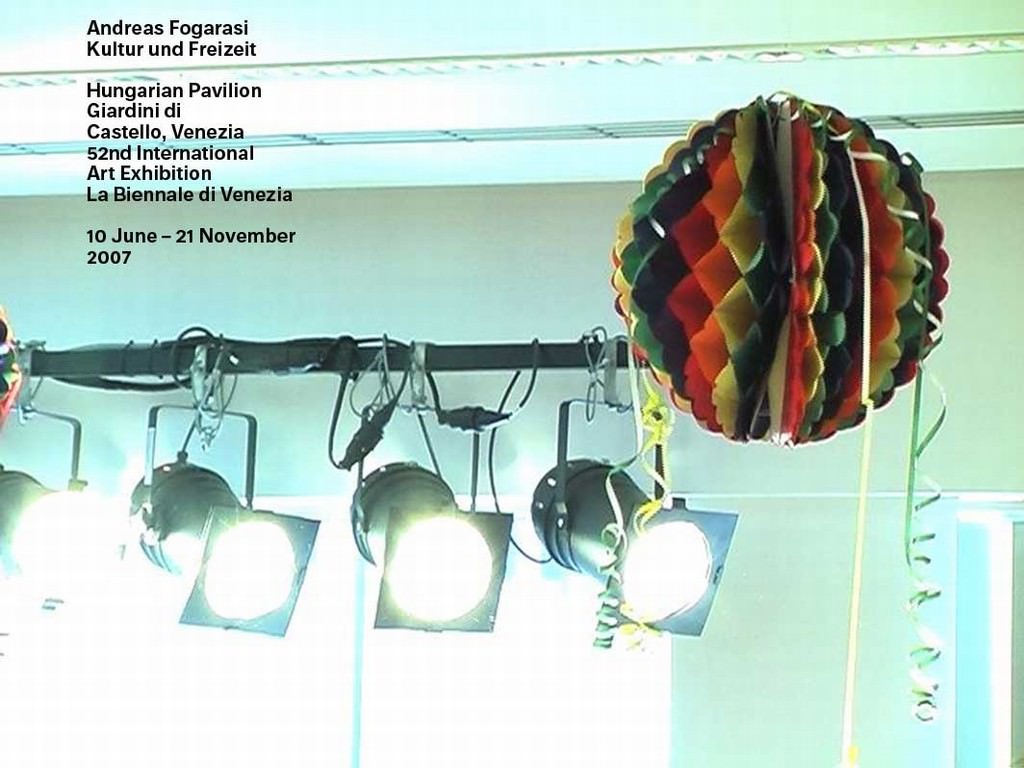Create an account
Welcome! Register for an account
La password verrà inviata via email.
Recupero della password
Recupera la tua password
La password verrà inviata via email.
-
-
- Categorie
- #iorestoacasa
- Agenda
- Archeologia
- Architettura
- Arte antica
- Arte contemporanea
- Arte moderna
- Arti performative
- Attualità
- Bandi e concorsi
- Beni culturali
- Cinema
- Contest
- Danza
- Design
- Diritto
- Eventi
- Fiere e manifestazioni
- Film e serie tv
- Formazione
- Fotografia
- Libri ed editoria
- Mercato
- MIC Ministero della Cultura
- Moda
- Musei
- Musica
- Opening
- Personaggi
- Politica e opinioni
- Street Art
- Teatro
- Viaggi
- Categorie
-
52 Biennale. Padiglione ungherese
Andreas Fogarasi rappresenta l’Ungheria con “Kultur und Freizeit (Culture and Leisure)”
Comunicato stampa
Segnala l'evento
The project ‘Kultur und Freizeit’ consists of a series of single channel videos, all showing the present state of different cultural centres in contemporary Budapest, projected in separate black boxes which both physically and structurally include the spectators, as well. It is these black boxes that the viewers encounter first as huge, minimalistic sculptural objects that seem to be utterly solidly built. As we, however, move along them, their construction structure gets revealed, thus creating an element of uncertainty in relation to their function –they are as much sophisticated micro-cinemas as they are simple wooden props.
These short videos are not straightforward documentaries since they don’t aim at providing the visitors with a comprehensive, anthropological survey of the current situation of these centres in a given place and at a given time. Rather, they function as signifiers for a contemporary split between mass culture and popular (i.e. vernacular) cultures, and their respective institutional frameworks, as opposed to high culture and its locations. This is emphasized by the particular use of camera movement, the extensive usage of stills, the subjective points of view, and the athmospheric quality of the images that trust in the narrative qualities of the architecture itself.
The phenomenon and the proliferation of cultural centres – at least in Hungary – unequivocally belong to the past political era in which one of the state’s fundamental missions was to democratize culture in the form of disseminating high culture to the masses. The origins of this endeavour date back not only to French cultural policy of the 1950s and to one of its leading agents, André Malraux, but also to the 19th century tradition of the workers’ club. In this respect, Fogarasi's project has a geographic and political relevance that goes well beyond the Hungarian capital.
Today, these centres are either closed down or used by various subcultural groups as a platform in the process of their identity formations via cultural means. They also function as stages of “simultaneous collective experience” (Walter Benjamin) which the masses are able to organize and control. In spatial terms, the locations of both mainstream mass culture and high culture are to be found elsewhere, in the symbolically taken centres, while these cultural centres belong to the social and cultural peripheries. In the temporal matrix, these centres are part of Hungary’s socialist past that has partly survived the political changes. Yet, for many people the complete disavowal of the past is the only means to overcome the effects of its traumatic experience.
Katalin Timár
Curator
These short videos are not straightforward documentaries since they don’t aim at providing the visitors with a comprehensive, anthropological survey of the current situation of these centres in a given place and at a given time. Rather, they function as signifiers for a contemporary split between mass culture and popular (i.e. vernacular) cultures, and their respective institutional frameworks, as opposed to high culture and its locations. This is emphasized by the particular use of camera movement, the extensive usage of stills, the subjective points of view, and the athmospheric quality of the images that trust in the narrative qualities of the architecture itself.
The phenomenon and the proliferation of cultural centres – at least in Hungary – unequivocally belong to the past political era in which one of the state’s fundamental missions was to democratize culture in the form of disseminating high culture to the masses. The origins of this endeavour date back not only to French cultural policy of the 1950s and to one of its leading agents, André Malraux, but also to the 19th century tradition of the workers’ club. In this respect, Fogarasi's project has a geographic and political relevance that goes well beyond the Hungarian capital.
Today, these centres are either closed down or used by various subcultural groups as a platform in the process of their identity formations via cultural means. They also function as stages of “simultaneous collective experience” (Walter Benjamin) which the masses are able to organize and control. In spatial terms, the locations of both mainstream mass culture and high culture are to be found elsewhere, in the symbolically taken centres, while these cultural centres belong to the social and cultural peripheries. In the temporal matrix, these centres are part of Hungary’s socialist past that has partly survived the political changes. Yet, for many people the complete disavowal of the past is the only means to overcome the effects of its traumatic experience.
Katalin Timár
Curator
08
giugno 2007
52 Biennale. Padiglione ungherese
Dall'otto giugno al 21 novembre 2007
arte contemporanea
Location
GIARDINI DI CASTELLO – PADIGLIONE UNGHERESE
Venezia, Fondamenta dell'Arsenale, (Venezia)
Venezia, Fondamenta dell'Arsenale, (Venezia)
Orario di apertura
10-18, chiuso lunedì
Vernissage
8 Giugno 2007, ore 15.30
Sito web
www.biennale07.hu
Autore
Curatore









